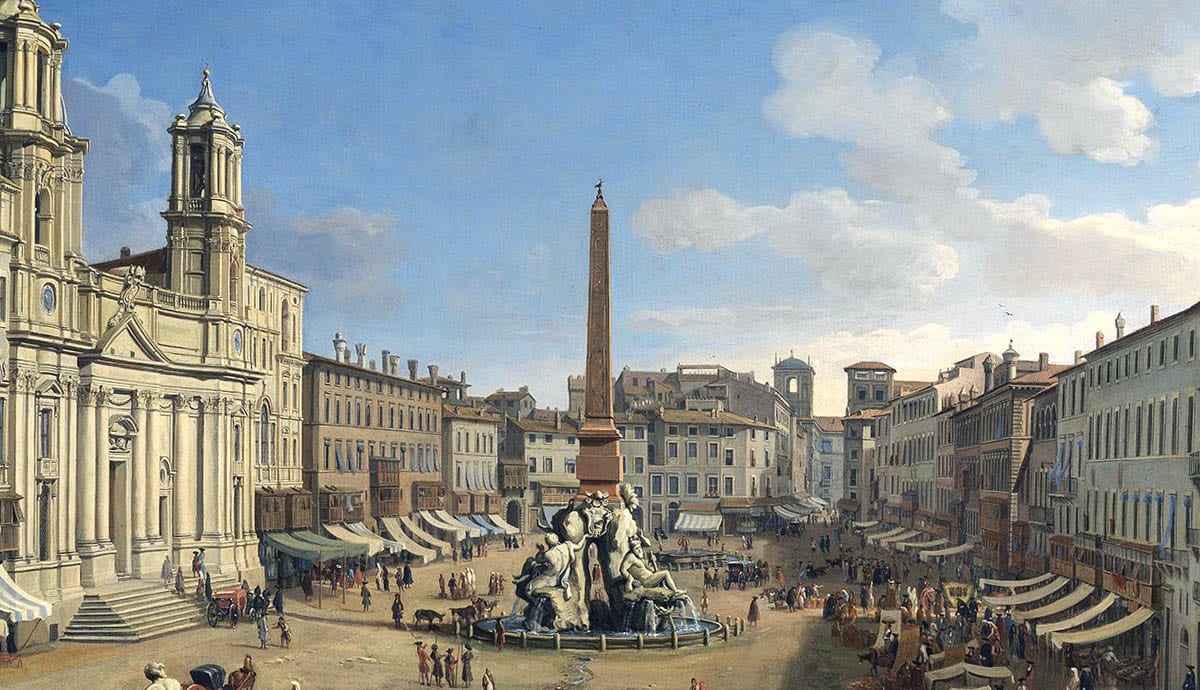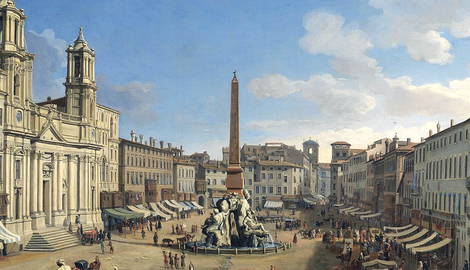
Between the reigns of Augustus and Theodosius I, numerous Egyptian obelisks were expatriated to Europe. These monoliths of antiquity would impress any conqueror. But in ancient Rome, their significance took on a multifaceted nature. To start with the obvious, they represented imperial power.
When the Romans captured Alexandria in 30 BC, they were overwhelmed by the majesty of its Egyptian monuments. Augustus was now a self-styled Pharaoh, and Egypt his most prestigious province. He asserted his rule by first appropriating its preeminent symbol of power. Standing as tall as 100 feet (excluding their bases) and flanking the entrances of temples across the country, no objects better represented that power than Egyptian obelisks.

In 10 BC, Augustus removed two from Heliopolis, the City of the Sun, and transported them to Rome by boat — a titanic effort. His achievement in this bold endeavor established a precedent that many successive emperors would go on to imitate. And long after the fall of Rome, global superpowers like Great Britain, France, and the United States would also follow suit. For this reason, today there are more Egyptian obelisks abroad than in Egypt.
Egyptian Obelisks In Ancient Rome

The first two obelisks in Rome were erected in the most conspicuous locations. One was placed in the Solarium Augusti at the Campus Martius. It served as the gnomon of a giant sundial. Zodiac symbols indicating months of the year were installed around its base. And it was situated in such a fashion that its shadow would highlight Augustus’s birthday, the Autumn Equinox.
The implication in doing so was that Augustus, at the helm of a new Roman Empire, appropriated thousands of years of Egyptian history. Any visitor laying eyes on the obelisk in the Campus Martius understood that the proverbial baton had passed from one great civilization to another.

The obelisk’s utility as a horologe was also important. As the renowned South African clacissist Grant Parker noted, “the authority to measure time can be an index of state power.” In selecting an object with such a function as Rome’s prize of appropriation, the message was clear that a new Roman era had begun.
The other obelisk, now located on the Piazza del Popolo, was initially erected at the center of ancient Rome’s Circus Maximus. This stadium was the city’s premier venue for public games and chariot racing. Six others were transported to Rome by later emperors, and five were constructed there.

The tallest among them currently stands before the Archbasilica of St. John Lateran in Rome. It is one of a pair of obelisks Constantine the Great wished to import from Egypt before he died. He did what Augustus dared not do out of fear of sacrilege: Constantine had the tallest obelisk in the world ripped from its consecrated place at the center of the temple of the sun and carted off to Alexandria.
As the first Christian emperor, he didn’t share Augustus’s reverence for the sun god. To the new, monotheistic Roman empire, the Egyptian obelisk degenerated in status to that of a novelty item. Its possession became nothing more than a token of state pride. However, Constantine died before he could arrange for the obelisk to make its journey across the Mediterranean.
With an equal disdain for paganism, his son and successor, Constantius II, honored Constantine’s wishes posthumously. He had the obelisk removed from Alexandria to Rome, where it towered over Augustus’s on the spina of the Circus Maximus.

As an audience changes, so does the object’s meaning. The ancient Rome of the 4th Century AD, rapidly Christianizing under the House of Constantine, no longer viewed Egyptian monuments with Caesar Augustus’s superstitions.
Ancient Significance Of Egyptian Obelisks: How And Why Were They Made?

If Egyptian obelisks broadly represented power and legacy appropriation to the Romans, the question remains as to what their original makers intended.
Pliny the Elder tells us that a certain King Mesphres commissioned the first of these monoliths during Egypt’s Early Dynastic Period. Symbolically, it honored the sun god. However, its function was to divide the day into two halves with its shadow.

Later pharaohs erected obelisks perhaps out of equal parts devotion to the gods and worldly ambition. There was a sense of prestige attached to them. Part of that prestige was in the actual movement of the monoliths.
Egyptian obelisks were always hewn from a single stone, which made their transport particularly tricky. They were mainly quarried near Aswan (where a massive unfinished one still remains) and often composed of a pink granite or sandstone.
Queen Hatshepsut commissioned two particularly large obelisks during her reign. In her own display of power, she had them showcased along the Nile before installing them at Karnak.
This notion that the gargantuan effort required to transport Egyptian obelisks imbued them with an enhanced sense of prestige and wonder was also a factor in ancient Rome. Perhaps even more so, as they were now being shipped not only down the Nile but across the sea.
Monumental Efforts: Transportation of Egyptian Monuments

The labor required to load an Egyptian obelisk on a riverboat in Aswan and deliver it to another Egyptian city was enormous. But this enterprise was light work in comparison to that of the Romans. They had to lower, load, transport out of the Nile, across the Mediterranean, into the Tiber, and then re-install at a site in Rome — all without breaking or damaging the stone.
The Roman historian Ammianus Marcellinus describes the naval vessels that were custom-made for this task: they were of a “size hitherto unknown” and had to be operated by three hundred oarsmen each. These ships arrived in Alexandria’s port to receive the monoliths after they were hauled up the Nile by smaller boats. From there they crossed the sea.
After reaching safety at the port of Ostia, other ships specially-made to cruise the Tiber received the monoliths. This, unsurprisingly, would leave gathering throngs of provincial onlookers awestruck. Even after the successful delivery and erection of obelisks, the vessels that had transported them were treated with almost equal admiration.
Caligula had one ship involved in the transport of his Egyptian obelisk, which is today the centerpiece of Vatican City, on display in the Bay of Naples for a time. Unfortunately, it fell victim to one of many infamous conflagrations that ravaged Italian cities in that period.
Evolving Symbolic Significance Of Egyptian Obelisks

Every Egyptian obelisk is propped up on a base. And though they are certainly less interesting to look at, bases often have a more compelling story to tell than the obelisks themselves.
Sometimes they’re as straightforward as an inscription detailing the transportation process of the Egeyptian monument in Latin. This was the case with the original base of Constantius’s Lateran Obelisk, which is still buried in the Circus Maximus ruins.
In other instances, they were written in such a way that their meaning was intentionally indiscernible.
The Egyptian obelisk that currently stands on the Piazza Navona is an example of this. It was commissioned by Domitian to be crafted in Egypt. He gave explicit direction that both its shaft and base were inscribed with Middle Egyptian hieroglyphics. The hieroglyphs on the shaft proclaim the Roman emperor to be the “living image of Ra.”

As few Romans were learned in Middle Egyptian epigraphy, it’s clear that Domitian’s intent was not for it to be understood. But, rather, in appropriating Egypt’s ancient script, he was doubling down on Rome’s assertion of power over it. And in no uncertain terms, these monoliths anointed ancient Rome as the inheritance of Egypt.
It’s also worth noting that Domitian could have easily had an obelisk of similar workmanship hewn in Italy — in fact, other emperors had. His direct commissioning of the work in Egypt is proof that value was added by the object’s transport from that country.
The Ongoing Legacy Of Egyptian Obelisks

The Romans may have been the first to acquire Egyptian obelisks, but they wouldn’t be the last. One could say that Caesar Augustus’s actions back in 10 BC started a snowball effect. Not only Roman emperors but also French kings and American billionaires went on to procure them in later history.
In the 1800s, the Kingdom of France was gifted the pair of Egyptian obelisks that once stood outside Luxor Temple by then Pasha Muhammad Ali. The French were the global superpower of the day, and Ali intended to tighten Franco-Egyptian relations with this gesture.
It took more than two years and 2.5 million dollars to haul the monolith to Paris. The French barge, “Le Louqsor,” departed Alexandria for Toulon in 1832 after being trapped in Egypt for a whole year while waiting for the Nile to flood. Then it traveled from Toulon through the Strait of Gibraltar and up the Atlantic, finally debarking in Cherbourg.
The Egyptian monument was floated down the River Seine, where King Louis Philippe II received it in Paris in 1833. Today it stands on the Place de la Concorde.
Needless to say, one long and expensive journey was enough for the French. They never returned to pick up the other half of the pair, which still stands at Luxor.

In the following century, the Egyptian government advertised the availability of two Alexandrian obelisks on the condition that the recipients fetched them. One went to the Brits. The other was offered to the Americans.
When William H. Vanderbilt heard of the opportunity he pounced. He promised any sum of money to get the remaining obelisk back to New York. In his letters negotiating the deal, Vanderbilt took a very Roman attitude toward acquiring the monolith: he said something to the effect that if Paris and London each had one, New York would need one too. Almost two millennia later, the possession of an Egyptian obelisk was still regarded as a great legitimizer of empires.
The offer was accepted. The obelisk departed for North America on a long and quite bizarre journey, as detailed by The New York Times. It was erected in Central Park in January 1881. Today it stands behind the Metropolitan Museum of Art and is known by its sobriquet, “Cleopatra’s Needle.” It’s the last Egyptian obelisk that will ever live in permanent exile from its homeland.
Probably for the best, the Arab Republic of Egypt has finally put an end to what ancient Rome started. No Egyptian monuments, obelisks or other, that are discovered on Egyptian soil may leave Egyptian soil from now onward.










